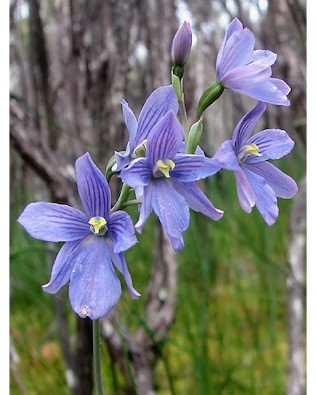The large veined sun orchid
(Thelymitra venosa)

Description
Thelymitra venosa, commonly known as the large veined sun orchid, is a species of orchid that is endemic to New South Wales. It has a single fleshy, channelled leaf and up to six relatively large, bright-blue flowers with darker veins. The arms on the side of the column are twisted and yellow, but not toothed at the tip. Unlike most other thelymitras, the flowers do not usually close on cloudy days. Thelymitra venosa is a tuberous, perennial herb with a single fleshy, channelled linear leaf 150–300 mm (6–10 in) long and 5–7 mm (0.2–0.3 in) wide. Up to six bright blue flowers with darker veins, 35–50 mm (1–2 in) wide are arranged on a flowering stem 400–700 mm (20–30 in) tall. The sepals and petals are 16–25 mm (0.6–1 in) long and 8–10 mm (0.3–0.4 in) wide. The labellum (the lowest petal) is larger than the other petals and sepals. The column is white or mauve, 6–8 mm (0.24–0.31 in) long and about 3 mm (0.1 in) wide. The lobe on the top of the anther is short with a few glands. The side arms on the column are yellow and twisted. Unlike most other sun orchids, the flowers do not usually close in cloudy weather and sometimes remain open at night. Flowering occurs from October to January. Thelymitra venosa was first formally described in 1810 by Robert Brown and the description was published in Prodromus Florae Novae Hollandiae et Insulae Van Diemen. The specific epithet (venosa) is derived from a Latin word meaning "veiny". The large veined sun orchid grows with low shrubs, sedges, and mosses on sandstone rock ledges in the Blue Mountains and nearby coastal areas. Thelymitra, commonly known as sun orchids, is a genus of more than 100 species of plants in the orchid family, Orchidaceae. Unlike most other orchids, sun orchids lack a highly modified labellum and all three petals are similar in size, shape and colour. The column is, however, highly modified and usually has prominent wings or glands which are helpful in identifying the species. Most sun orchids close their flowers at night, in cloudy or cool weather, giving rise to their common name. The scientific name means "woman's hood" and refers to the hooded column present in most, but not all species. Most species are endemic to Australia although some are found as far from there as the Philippines and Indonesia. The type species, Thelymitra longifolia, the first to be formally described, was collected in New Zealand.
Taxonomic tree:







